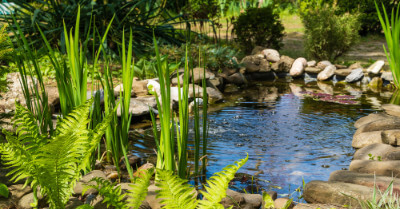Table of Contents
What Does Hardscaping Mean?
Hardscaping is all about adding non-living materials and elements to your yard. It completes the look of the landscape by adding beautiful features and functioning components. Hardscape materials serve multiple purposes, such as:
- Stopping water runoff
- Improving irrigation
- Preventing erosion
- Offering barriers and privacy
- Elevating specific areas
- Drawing attention
- Providing outdoor living space
When Hardscaping Is Considered Construction
In most cases, hardscaping is considered construction. But there are a few exceptions, such as adding already-built items to your landscape, like birdbaths. In this case, you would just go out and purchase the item, transport it home and place it in the yard.
So, what is hardscape construction? These are elements that require constructing either off-site or directly within your landscape. They can include practical and aesthetic additions to your outdoor space in various ways, such as:
Arbors, Gazebos & Pergolas – The most commonly used material for constructing these hardscapes is wood. Other options include vinyl and fiberglass.
Fences – Chain link fences can be made of coated iron or steel. Other much more visually appealing options include wood and vinyl fencing.
Pathways & Walkways – These are commonly created using stone or brick. But gravel is a much more affordable alternative.
Patios – Brick can be expensive, but it makes the area look upscale. Concrete is a low-maintenance material commonly used to construct patios and other hardscapes. Flagstone is a low-cost option that gives your yard a natural look.
Water Features – Fountains, ponds and birdbaths are commonly constructed using metal, ceramics, fiberglass, cast stone and even plastic.
Questions to Ask Your Hardscape Contractor
Oftentimes, building a hardscape can be a long, tedious, complicated process. Many of the common hardscape structures can be hard to build for newbies. But they are vital to your home’s landscape because they add to its look, feel and functionality.
Hardscapes can be constructed as attachments to your house, such as a deck. They are also created as support for other structures, such as a patio that houses an outdoor fireplace, barbecue pit or jacuzzi. Getting the job done right is very important because redoing the construction can be extremely costly.
So, what types of questions should you ask before hiring a hardscape contractor? And once you ask the right questions, how do you know if you received the right answer? Well, I’ve done some digging and this is what I came up with:
1. How do you complete the sub-base prep and excavation?
A reputable, licensed contractor will excavate a common hardscape in a way where it can be constructed on soil that hasn’t been disturbed. Most use Geotextile fabric to segregate and compact the sub-soils away from the base material.
2. What type of base material do you use?
It should consist of granular stone with 21AA designated gravel or other types of fines, not pea stone or slag sand.
3. How do you complete the compaction process?
The base layer compaction should take place while it’s being constructed. Most experts do it about every 2-3 inches.
4. Do you use Geotextile fabric for the hardscape construction?
Geotextile fabric is a must for preventing intermixing. It should be used between the base gravel and the subsoil, or on vertical surfaces that stand the chance of losing sand or base gravel due to washout, like behind retaining walls.
5. What type of edge restraint do you use and why?
Depending on your area, concrete tends to crack. If it does, it can’t effectively keep the paver pavement stable. Unless the concrete is reinforced, many paver experts suggest using steel spikes and vinyl edge restraint.
6. When using jolting sand, what type do you use?
Polymeric (acrylic) sand and standard angular jolting sand are both suitable for constructing hardscapes. With Polymeric sand, you get a flexible product, much like mortar. This tends to suppress weeds and keep ants from creating ant hills in the concrete pavers.
If the hardscape contracting company says they use regular play sand, run for the hills. This material should never be used in hardscape construction unless you’re throwing it down in your kids’ play area.
Why You Should Add Hardscaping to Your Landscape
Hardscapes (non-living features and materials) should be combined with softscapes (living things) to create a cohesive outdoor space that has both function and style. Here are some of the benefits of adding hardscaping to your landscaping project:
1. More Living Space
Outdoor rooms, kitchens, lounge areas and patios add to your outdoor living space. They add value to the area by making it an entertaining place for you and your guests.
2. Higher Property Value
When you add hardscaping to your front yard, you improve your home’s curb appeal which increases its value. Even in the backyard, you can increase the home’s value by up to 500% by simply adding an outdoor patio to the landscape.
3. Define Spaces
A great way to add style to your yard is by defining spaces. Create physical and visual borders by installing retaining walls, pergolas, arbors, gazebos and built-in seating in your garden.
4. Beautification
Create awesome focal points and add diversity to the landscape by adding hardscapes with various colors, textures, layers and styles. Some great ideas include garden boxes, flower beds, pergolas and tiered patios.
5. Grade & Erosion Issues
Sloping grades and uneven yards can lead to erosion problems and other issues. Hardscaping is an effective way to deal with this while making the space functional. Stairs, retaining walls and walkways make it easier to access sloping areas so you can actually use the area to garden.
Recent Articles



















